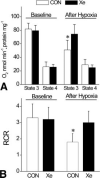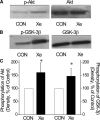Xenon preconditioning: the role of prosurvival signaling, mitochondrial permeability transition and bioenergetics in rats
- PMID: 19224794
- PMCID: PMC2748301
- DOI: 10.1213/ane.0b013e318192a520
Xenon preconditioning: the role of prosurvival signaling, mitochondrial permeability transition and bioenergetics in rats
Abstract
Background: Similar to volatile anesthetics, the anesthetic noble gas xenon protects the heart from ischemia/reperfusion injury, but the mechanisms responsible for this phenomenon are not fully understood. We tested the hypothesis that xenon-induced cardioprotection is mediated by prosurvival signaling kinases that target mitochondria.
Methods: Male Wistar rats instrumented for hemodynamic measurements were subjected to a 30 min left anterior descending coronary artery occlusion and 2 h reperfusion. Rats were randomly assigned to receive 70% nitrogen/30% oxygen (control) or three 5-min cycles of 70% xenon/30% oxygen interspersed with the oxygen/nitrogen mixture administered for 5 min followed by a 15 min memory period. Myocardial infarct size was measured using triphenyltetrazolium staining. Additional hearts from control and xenon-pretreated rats were excised for Western blotting of Akt and glycogen synthase kinase 3 beta (GSK-3beta) phosphorylation and isolation of mitochondria. Mitochondrial oxygen consumption before and after hypoxia/reoxygenation and mitochondrial permeability transition pore opening were determined.
Results: Xenon significantly (P < 0.05) reduced myocardial infarct size compared with control (32 +/- 4 and 59% +/- 4% of the left ventricular area at risk; mean +/- sd) and enhanced phosphorylation of Akt and GSK-3beta. Xenon pretreatment preserved state 3 respiration of isolated mitochondria compared with the results obtained in the absence of the gas. The Ca(2+) concentration required to induce mitochondrial membrane depolarization was larger in the presence compared with the absence of xenon pretreatment (78 +/- 17 and 56 +/- 17 microM, respectively). The phosphoinositol-3-kinase-kinase inhibitor wortmannin blocked the effect of xenon on infarct size and respiration.
Conclusions: These results indicate that xenon preconditioning reduces myocardial infarct size, phosphorylates Akt, and GSK-3beta, preserves mitochondrial function, and inhibits Ca(2+)-induced mitochondrial permeability transition pore opening. These data suggest that xenon-induced cardioprotection occurs because of activation of prosurvival signaling that targets mitochondria and renders them less vulnerable to ischemia-reperfusion injury.
Figures





Similar articles
-
Noble gases without anesthetic properties protect myocardium against infarction by activating prosurvival signaling kinases and inhibiting mitochondrial permeability transition in vivo.Anesth Analg. 2007 Sep;105(3):562-9. doi: 10.1213/01.ane.0000278083.31991.36. Anesth Analg. 2007. PMID: 17717207
-
Rosuvastatin protects isolated hearts against ischemia-reperfusion injury: role of Akt-GSK-3β, metabolic environment, and mitochondrial permeability transition pore.J Physiol Biochem. 2020 Feb;76(1):85-98. doi: 10.1007/s13105-019-00718-z. Epub 2020 Jan 8. J Physiol Biochem. 2020. PMID: 31916218
-
Isoflurane postconditioning prevents opening of the mitochondrial permeability transition pore through inhibition of glycogen synthase kinase 3beta.Anesthesiology. 2005 Nov;103(5):987-95. doi: 10.1097/00000542-200511000-00013. Anesthesiology. 2005. PMID: 16249673
-
Mitochondria and GSK-3beta in cardioprotection against ischemia/reperfusion injury.Cardiovasc Drugs Ther. 2010 Jun;24(3):255-63. doi: 10.1007/s10557-010-6234-z. Cardiovasc Drugs Ther. 2010. PMID: 20490903 Review.
-
Role of glycogen synthase kinase-3beta in cardioprotection.Circ Res. 2009 Jun 5;104(11):1240-52. doi: 10.1161/CIRCRESAHA.109.197996. Circ Res. 2009. PMID: 19498210 Free PMC article. Review.
Cited by
-
Xenon enhances LPS-induced IL-1β expression in microglia via the extracellular signal-regulated kinase 1/2 pathway.J Mol Neurosci. 2011 Sep;45(1):48-59. doi: 10.1007/s12031-010-9432-z. Epub 2010 Aug 3. J Mol Neurosci. 2011. PMID: 20680516
-
Effect of Inhaled Xenon on Cardiac Function in Comatose Survivors of Out-of-Hospital Cardiac Arrest-A Substudy of the Xenon in Combination With Hypothermia After Cardiac Arrest Trial.Crit Care Explor. 2021 Jul 29;3(8):e0502. doi: 10.1097/CCE.0000000000000502. eCollection 2021 Aug. Crit Care Explor. 2021. PMID: 34345828 Free PMC article.
-
Renal function following xenon anesthesia for partial nephrectomy-An explorative analysis of a randomized controlled study.PLoS One. 2017 Jul 18;12(7):e0181022. doi: 10.1371/journal.pone.0181022. eCollection 2017. PLoS One. 2017. PMID: 28719609 Free PMC article. Clinical Trial.
-
Xenon improves neurologic outcome and reduces secondary injury following trauma in an in vivo model of traumatic brain injury.Crit Care Med. 2015 Jan;43(1):149-158. doi: 10.1097/CCM.0000000000000624. Crit Care Med. 2015. PMID: 25188549 Free PMC article.
-
Developments in the Study of Inert Gas Biological Effects and the Underlying Molecular Mechanisms.Int J Mol Sci. 2025 Aug 5;26(15):7551. doi: 10.3390/ijms26157551. Int J Mol Sci. 2025. PMID: 40806678 Free PMC article. Review.
References
-
- Kersten JR, Schmeling TJ, Pagel PS, Gross GJ, Warltier DC. Isoflurane mimics ischemic preconditioning via activation of KATP channels: reduction of myocardial infarct size with an acute memory phase. Anesthesiology. 1997;87:361–70. - PubMed
-
- Novalija E, Fujita S, Kampine JP, Stowe DF. Sevoflurane mimics ischemic preconditioning effects on coronary flow and nitric oxide release in isolated hearts. Anesthesiology. 1999;91:701–12. - PubMed
-
- Toller WG, Gross ER, Kersten JR, Pagel PS, Gross GJ, Warltier DC. Sarcolemmal and mitochondrial adenosine triphosphate-dependent potassium channels: mechanism of desflurane-induced cardioprotection. Anesthesiology. 2000;92:1731–9. - PubMed
-
- Wilhelm S, Ma D, Maze M, Franks NP. Effects of xenon on in vitro and in vivo models of neuronal injury. Anesthesiology. 2002;96:1485–91. - PubMed
Publication types
MeSH terms
Substances
Grants and funding
LinkOut - more resources
Full Text Sources
Miscellaneous

